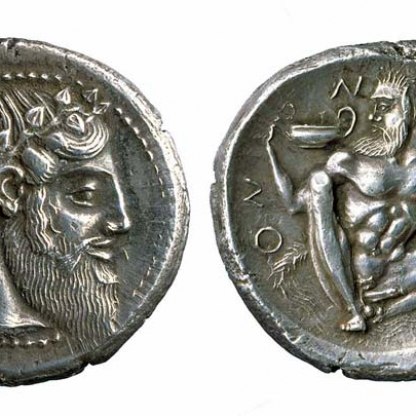The Pashley Sarcophagus

Spare me, Liber, spare me, fearful god of the mighty ivy-rod.
Horace, Odes, Book II, 19, 7-8.
Liber was one of the names of Bacchus, the Roman god of wine (Dionysos to the Greeks). In Latin liber literally means ‘free’ – and the ability of this god to liberate men from their earthly cares made him one of the most popular deities of the later Roman empire. But worship of Bacchus did not simply involve drowning one’s sorrows in wine. This powerful god also offered man the promise of life after death.
The frieze so expertly carved along the front of this marble sarcophagus depicts the triumphant return of Bacchus from India, having 'civilised' the East with the gift of the grape. He is accompanied here by an entourage of human and semi-human co-revellers. The sarcophagus was discovered in pieces on the Greek island of Crete in the eighteenth century, but it is thought to have been made on the Italian mainland, probably in Rome. It must once have contained the body of a wealthy citizen of the empire, an individual who had put his hopes for the afterlife in worship of the wine god.
At the far left of the frieze is a maenad, or bacchante – a female follower of Bacchus. She holds up a tambourine, oblivious of her garment's being whisked off in the slipstream of the god’s chariot. Bacchus himself, wearing a panther skin, stands up in the chariot car. A smooth-skinned youth, hair flowing down his shoulders, he is almost feminine in appearance. The god’s androgynous qualities are well attested in literature of the time.
Under his protective arm huddles a young satyr, perhaps Ampelus, Bacchus’ favourite. Satyrs were traditionally the wild and lustful drinking companions of the god. A late sixth-century Athenian black-figure amphora in the Fitzwilliam, left [GR.27.1864], shows a typical troupe of them, drunkenly cavorting to the sound of pipes. The young Ampelus on the sarcophagus seems less bestial, but his pedigree is betrayed by his pointed ears and the little tail sticking out of the small of his back.
Bacchus is crowned with his usual ivy wreath. We see it also on a small second/first-century BCE bronze bust in the Fitzwilliam, left [GR.119.1937]. In his free hand he carries his thyrsos, a wooden wand, sometimes bound with ivy, and topped, as here, with a pine cone.
The chariot is powered by centaurs, creatures with the bodies and legs of horses, and the torsos, arms and heads of humans, often associated in Greek myth with drunkenness and violence. This tipsy pair seem harmless enough, if a little ineffectual as a chariot team. The centaur seems to fondle the centauress – a comparatively rare creature in Roman art. He holds a drinking horn aloft, while she dangles an empty wine cup over his shoulder.
In front of the centaurs is the raucous heart of the procession: the god Pan, who raps a tambourine and stamps his cloven feet in ecstasy. This god of the wilds appears twice elsewhere on the sarcophagus: once, carved onto Bacchus' chariot car, being teased by the god Eros; and again on one of the end panels, where he is shown drunk, supported by a pair of small winged figures. This last scene is balanced, at the other end, by a relief depicting the baby Bacchus being carried in a basket by two satyrs.
Pan was an important figure in Bacchus’ entourage. He and Silenos, the snub-nosed satyr who leans towards him here, were the god’s generals on his expedition to the East. Silenos, the most senior and bibulous of the satyrs, is shown in an advanced state of inebriation. Companions try to hold him upright but his attention has been caught by something – Pan’s tambourine, perhaps, or the centaur’s drinking horn – and he lurches against the flow of the procession.
In front of Silenos a more sober and responsible satyr carries a baby on his shoulders. Ahead of him is an elephant that the company have presumably picked up in the East (although it is an African elephant that is depicted here). The animal, and the satyrs and maenads riding on its back, are shown on a greatly reduced scale, but the group provides a neat balance to the centaurs and chariot at the other end of the relief.
Leading the procession are another drunken satyr, holding a bulging wine skin over his shoulder, and a panther who turns round to look at him.
A subsidiary frieze, above the main relief, shows satyrs and nymphs reclining on animal skins as they drink and listen to one of their number playing the lyre.
To modern viewers, the subject might seem to be an inappropriate one with which to decorate something so solemn as a coffin. But the triumphant return of Bacchus from the East was an event celebrated and re-enacted by worshippers of the god at spring festivals. It was associated with rebirth and new life. Bacchus, the care-freeing god, offered his followers liberation from their earthly concerns and salvation beyond the grave.
Themes and periods
Data from our collections database
Sarcophagus, with relief showing triumphal return of Dionysos.
Acquisition and important dates
- Method of acquisition: Given
- Dates: 1835
Dating
carved
Maker(s)
Note
Carved
Place(s) associated
- Italy
Materials used in production
Read more about this record3D scan
Accessibility Notice:
The 3D model on this page is hosted on Sketchfab and may not be fully accessible to everyone, including users of assistive technologies. We apologize for any inconvenience.
Audio description
Other highlight objects you might like
Suggested Curating Cambridge products
Sign up to our emails
Be the first to hear about our news, exhibitions, events and more…





